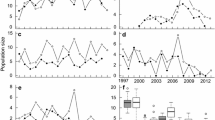Abstract
Following predictions from climatic general circulation models, the effects of perturbations in global climate are expected to be most pronounced in the Northern Hemisphere. Elaborating on a recently developed plant–herbivore–climate model, we explore statistically how different winter climate regimes and density-dependent processes during the past century have affected population dynamics of two arctic ungulate species. Our analyses were performed on the dynamics of six muskox and six caribou populations. In muskoxen, variation in winter climate, mediated through the North Atlantic Oscillation (NAO), explained up to 24% of the variation in interannual abundance, whereas in caribou up to 16% was explained by the NAO. Muskoxen responded negatively following warm and snowy winters, whereas caribou responded negatively to dry winters. Direct and delayed density dependence was recorded in most populations and explained up to 32% and 90% of variations in abundance of muskoxen and caribou, respectively.
Similar content being viewed by others
Author information
Authors and Affiliations
Additional information
Received: November 19, 2001 / Accepted: May 28, 2002
Rights and permissions
About this article
Cite this article
Forchhammer, M., Post, E., Stenseth, N. et al. Long-term responses in arctic ungulate dynamics to changes in climatic and trophic processes. Popul Ecol 44, 113–120 (2002). https://doi.org/10.1007/s101440200013
Issue Date:
DOI: https://doi.org/10.1007/s101440200013




